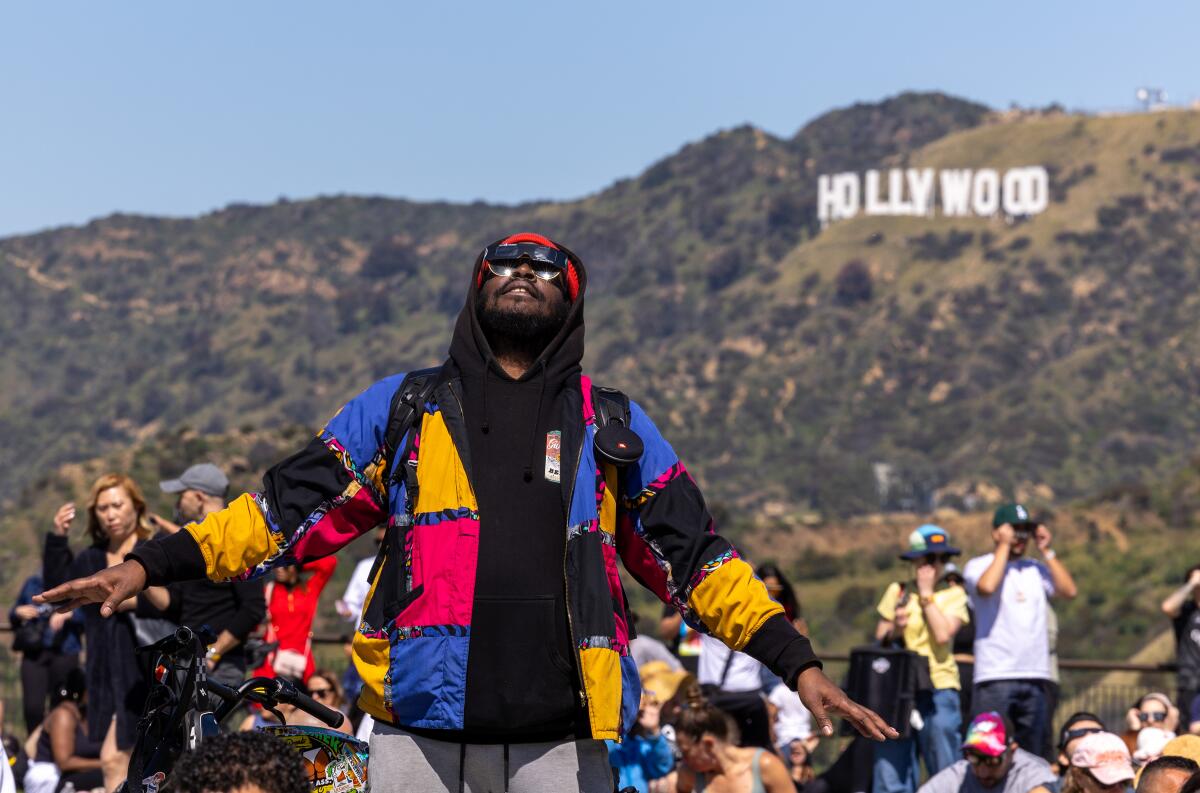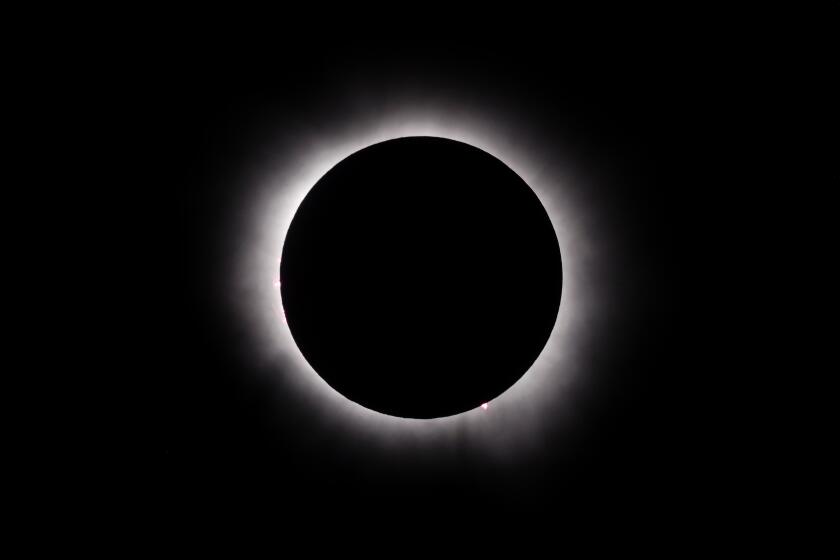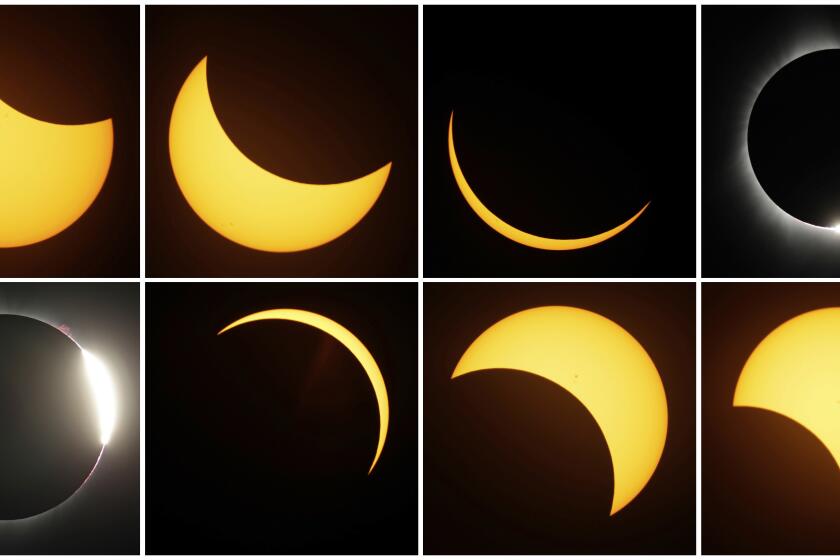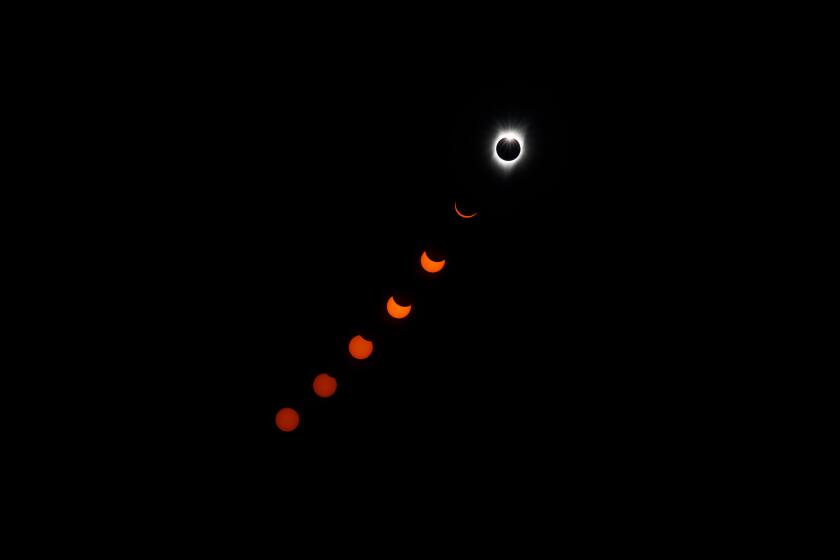Solar eclipse thrills crowds in California as it darkens swath of countryside

- Share via
Bhavini Lad’s three children were so fired up to experience their first solar eclipse on Monday that standing in line to pick up protective eyewear at the California Institute of Technology campus was almost too much to bear.
The 7-year-old twins and their 5-year-old brother buzzed and jumped, chatting with people in the line around them. They spoke with great enthusiasm about their space-themed bedroom that features a replica solar system hanging from the ceiling.
“They love to learn about it because they have the stuff in their room,” said Lad, an aerospace engineer, adding that they’ve talked about how to view the phenomenon without risk of eye injury.
“You don’t look without the glasses because what will happen?” Lad asked her son.
He shouted his response: “You’ll get blind!”
Millions of people across the U.S., including in Southern California, looked up at the sky to witness a rare total solar eclipse Monday.
The sense of excitement was mirrored in the rest of the crowd of roughly a thousand revelers, who donned protective eyewear to witness the scientific wonder of a partial solar eclipse at the athletic field near the Cahill Center for Astronomy and Astrophysics. It was just one of numerous eclipse-watching events, formal or otherwise, held Monday morning across the Southland.
Whereas more than a dozen states were able to experience a rare total solar eclipse, in which the moon completely blocks the face of the sun, viewers in Los Angeles saw the moon take a roughly 50% bite out of the bright mass.
Unlike elsewhere in the country, where cloudy skies risked spoiling the eclipse chasers’ view, it was a sunny, clear day in Los Angeles, with temperatures in the mid-70s. And because L.A. didn’t experience totality, the sky didn’t go dark and temperatures didn’t drop by several degrees, as they did for those places in the moon’s complete shadow.
In Los Angeles, it cooled slightly at the peak of the eclipse “because we were only receiving about half the energy from the sun,” said Kenneth E. Phillips, curator for aerospace science at the California Science Center.
Monday’s eclipse began over the South Pacific Ocean and moved diagonally across Mexico, the United States and Canada. More than 30 million Americans from Texas to Maine lived in the path of totality.
Monday’s celestial event was the last total solar eclipse that will be seen from the contiguous United States until 2044. Los Angeles will experience another partial solar eclipse in 2029, according to NASA.
Why would someone journey across the country to watch a total eclipse? Because it’s more than just an astronomical rarity: It may be the best show in the universe.
The buzz leading up to the total eclipse was significant, for both the scientific possibilities and the rarity.
“It’s an opportunity to see firsthand our place in the universe,” said Paul Robertson, an associate professor of physics and astronomy at UC Irvine. “We’re sitting on the surface of this rock that’s careening through space at a speed of 30 kilometers per second, and we’re doing this sort of gravitational dance with these other giant bodies.”
It’s not something that people often pause to think about, Robertson said.
Nancy Castellanos and her 5-year-old daughter, Camilla, sat on a striped picnic blanket outside the California Science Center with their eyes fixed on the sky.
Camilla smiled and pointed up to the sun, prompting her mother to remind her not to look up without her protective glasses. It was Camilla’s first eclipse and she wasn’t quite sure what to expect. They waited and watched as the moon moved in and out of partial sun-blocking position.
“It’s such a memorable event, especially for the children,” Castellanos, 39, said as Camilla cuddled in her lap. “She can remember this later on and watch the next one too.”
At Caltech, some families brought chairs and laid out blankets to relax and munch on snacks while they waited for the show to begin.
Ryan Rudes, a freshman at Caltech, skipped his math class to take photos of the eclipse, using a makeshift eclipse filter for his Canon T6 camera crafted from duct tape and lenses from his orange eclipse glasses. He had hoped to view the eclipse from Niagara Falls this year, but cloudy skies in the forecast for that region dashed his plans.
The crowd erupted in cheers as the eclipse reached its peak around 11:12 a.m. Some quickly began packing up their belongings to leave while others opted to wait in line to watch the eclipse begin its reverse journey through a large telescope set up on campus.
Awe is a serious topic among psychologists, including one at UC Irvine investigating whether awe-inspiring solar eclipses can help unite Americans.
Across the region, people’s creativity and scientific prowess were on display.
Zak Graff, manager for Pasadena City College’s Center for the Arts, viewed the eclipse through a makeshift pinhole camera he made using a recycled Honey Nut Cheerios box and aluminum foil.
A few times kids ran up to Graff hoping to snag a bite of the cereal, but they left disappointed. The box was for science, not snacks.
Graff also brought a spaghetti strainer he used to filter sunlight. The light reflecting on people’s clothes mirrored the eclipse happening in the sky in dozens of little crescent shadows. “Super low tech but highly effective,” Graff said.
Dani Ortuño Gudiño, a photographer working on his master’s degree in media studies, lay on the ground on his back outside the California Science Center to watch the eclipse reach its peak. He held a pair of paper glasses up to the lens of his camera, a Sony Alpha 7 III. The result was a crisp, stunning photo of the moon overlapping with the sun. The visible part of the sun was in a crescent shape overhead.
Nearby, Dalton Cantor, 16, held his glasses against his face as he gazed up at the sky.
“My family and I decided to come here to experience something unique,” he said. “It’s powerful. It pauses everything you’re going through.”
Dalton lives near the Science Center and used to visit nearly every weekend when he was younger. He was excited to be there Monday with his mother and grandmother.
“It’s a rare opportunity,” said his grandmother, Ana Rodriguez. “We couldn’t miss it.”
Edwin Lopez took advantage of the moment of calm after the eclipse’s peak to meditate.
He sat cross-legged and placed his hands on his heart as he listened to an eclipse-themed guided meditation in his earbuds. Lopez traveled to Oregon for the 2017 eclipse and has been looking forward to witnessing the event again. He took slow, steady breaths with his eyes closed as the crowd around him began to thin.
“This meditation is about finding the light inside your heart and letting it radiate through you like fire,” he said. “The eclipse is a very special moment and I wanted to feel connected to it.”
More to Read
Sign up for Essential California
The most important California stories and recommendations in your inbox every morning.
You may occasionally receive promotional content from the Los Angeles Times.
















